65 Years of “Stan the Man”: Stan Lee Meets The Amazing Spider-Man
By Jeb D.
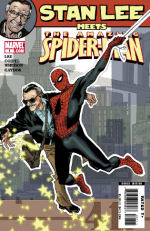 It’s been 65 years since Stan Lee first went to work for Marvel Comics. It seems amazing that he spent his first couple of decades there as an essentially anonymous hack, churning out the formula romances, Westerns, and monster stories the company wanted. The story of his eventual breakout, how he was instrumental in jump-starting the 60’s comics explosion and helped to create the Marvel Comics we know today, is fairly well known; what’ s interesting, in the context of this anniversary, is how quickly it was all over. The first issue of the Fantastic Four came out in 1961, and by decade’s end Lee had pretty much retired from the actual writing and editing of comics. He’s never completely left comics (or the Marvel superheroes he helped to create) behind, though, and this book is the first of several novelty issues that will have Lee interact with some of his most famous characters (and the series will mark the most writing Lee’s done for the company since his initial retirement). I’ll let others worry about the continuity issues.
It’s been 65 years since Stan Lee first went to work for Marvel Comics. It seems amazing that he spent his first couple of decades there as an essentially anonymous hack, churning out the formula romances, Westerns, and monster stories the company wanted. The story of his eventual breakout, how he was instrumental in jump-starting the 60’s comics explosion and helped to create the Marvel Comics we know today, is fairly well known; what’ s interesting, in the context of this anniversary, is how quickly it was all over. The first issue of the Fantastic Four came out in 1961, and by decade’s end Lee had pretty much retired from the actual writing and editing of comics. He’s never completely left comics (or the Marvel superheroes he helped to create) behind, though, and this book is the first of several novelty issues that will have Lee interact with some of his most famous characters (and the series will mark the most writing Lee’s done for the company since his initial retirement). I’ll let others worry about the continuity issues.
The first offering in this volume is the ten-page title story, and if Stan actually did write it, then I’m frankly impressed. Having slogged through a few of his recent “Just Imagine” titles for DC, I wouldn’t have thought he had it in him to turn out something this dry and pithy. Spider-Man, in vintage 70’s lament mode, drops in on Stan, moping about the difficulties of being Spider-Man. Stan, in the process of baking cookies, offers sly (and cynical) counsel, restoring his famous creation’s sense of responsibility (though, interestingly, Stan avoids the famous “power and responsibility” line). It’s really just a slight shaggy dog of a story, but it’s nice to see that Lee seems to know not to overstay his welcome. Artist Olivier Coipel delivers a clean, elegant Romita-like Spidey.
Joss Whedon’s story is a bit more oblique—it’s set in an interdimensional comic book convention, where different universes’s versions of the same comic fan discuss the effect—or lack of it—that Lee has had on comics in their universe. For Whedon, it’s pretty low-key, but effective, with some good laughs. And we don’t see enough artwork from Michael Gaydos, anyway, so he’s most welcome here.
For me, the heart of the book is the final new story: Fred Hembeck’s very funny two-page cartoon strip, in which some beloved Z-list characters have a spirited discussion about Lee. It’s funny stuff, but when they’re joined by Hembeck himself, he provides an encomium to Lee that would never have occurred to me, but which is amazingly apt for those of us who grew up reading the guy: it wasn’t Lee’s writing that the young Fred responded to so much as his crazy, larger-than-life persona. As Hembeck says, even though none of us actually “knew” Stan Lee, he was probably the coolest adult any of us had regular contact with—he was a grownup who loved comics just like we did. In a less-connected (and less cynical) world, that was no small thing.
I can’t see any obvious reason why they chose Amazing Spider-Man #87 as the reprint that fills out the book (Spidey thinks his powers might be killing him, and accidentally reveals his secret identity); there’s fewer Spidey witticisms than usual, and not much action. On the other hand, it features classic John Romita Sr. art, including his va-va-voom versions of Mary Jane and Gwen, as well as one hilariously “hip” party scene. The glossy pages make the coloring look more garish than the newsprint on which it originally appeared, but it’s not too distracting.
I’m getting a little tired of railing on Marvel about their pricing (and you might well be tired of reading me do it), so I’ll just say that your four bucks gets you 22 pages of enjoyable new material, and the aforementioned reprint. And it’s not like there’s going to be too many other comic pros celebrating their 65th anniversary any time soon.
RATING: 
Zombies? In A Comic? Whoda Thunk It?: Zombie #1
By Jeb D.
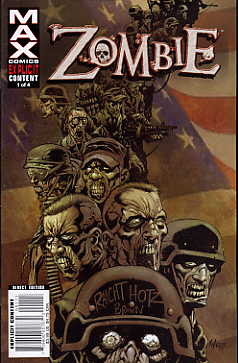 Zombies get used as symbols quite a bit. From George Romero to Robert Kirkman, the parallels between the walking dead, and those people who walk through life as though they were dead, are grist for the metaphoric mill. Sometimes, though, what a comic reader wants is just a dark and gory tale of desperate humanity faced with brain-chomping animated corpses. Why Marvel decided that their near-moribund MAX line needed such a story isn’t clear, but that’s just what Zombie appears to be.
Zombies get used as symbols quite a bit. From George Romero to Robert Kirkman, the parallels between the walking dead, and those people who walk through life as though they were dead, are grist for the metaphoric mill. Sometimes, though, what a comic reader wants is just a dark and gory tale of desperate humanity faced with brain-chomping animated corpses. Why Marvel decided that their near-moribund MAX line needed such a story isn’t clear, but that’s just what Zombie appears to be.
Two bank employees are taken hostage by the vicious gang that robbed their bank and slaughtered their co-workers. The getaway route takes them right into the heart of some kind of emergency situaion, that they eventually realize is a plague of shuffling, lip-smacking, flesh-munchers. Panic and disaster ensue, we meet some human surivivors, bood and guts are liberally dished out, and at issue’s end… more zombies. To be continued.
Writer Mike Raicht builds his story on tried-and-true horror/monster elements, and over the course of its 22 pages, it really doesn’t swerve from the expected. Artists Kyle Hotz and Dan Brown, though, give the story a wonderfully creepy look that’s more than a bit reminiscent of vintage EC horror, or the kind of stuff artists like Jack Davis were doing in the early days of Mad.
The problem with Zombie #1 is that, as a piece of serial storytelling, it’s hard to judge on its own. If the storyline continues along its linear path, it might be a decent, well-illustrated monster book, memorable only for the art. On the other hand, it’s certainly possible that the cliché setup is designed specifically to misdirect as to the book’s future intentions: in other words, how a reader ultimately feels about issue #1 is going to depend a great deal on how they wind up feeling about issue #2. And it’s a bit early for that.
Did someone say tradewait?
RATING: 
Bendis and Bagley Do It Up Right in Ultimate Spider-Man #100
By Jeb D.
 It’s a shame that this “centennial” issue falls in the middle of the most intriguing story arc this title has had for quite some time. Anyone expecting a retrospective, or horde of guest stars (or, heaven help us, the extra arms Spidey grew in ASM #100) is going to be disappointed; anyone who enjoys the way Brian Bendis puts the screws to poor Peter Parker, though, will shake their head and wonder just how much worse things can get for the poor guy.
It’s a shame that this “centennial” issue falls in the middle of the most intriguing story arc this title has had for quite some time. Anyone expecting a retrospective, or horde of guest stars (or, heaven help us, the extra arms Spidey grew in ASM #100) is going to be disappointed; anyone who enjoys the way Brian Bendis puts the screws to poor Peter Parker, though, will shake their head and wonder just how much worse things can get for the poor guy.
The setup? Oh, it’s pretty simple: Peter’s dad is alive and telling a story that seems near-insane, Aunt May’s nursing enough bitterness towards him and Spider-Man to chuck everyone out of the house, Gwen’s not sure just how alive she really is, Mary Jane’s still the prisoner of the ravaged Spider-Man clone, and darned if those extra arms actually do make an appearance after all (though not where you might think); by issue’s end, disaster has well and truly hit everyone involved. I’m not placing bets on which of the supporting cast will still be around when Bendis and Bagley break the Lee/Kirby consecutive-issue record in a few months (come to think of it, this being a Clone Saga, I’m not sure I’d put a lot of money on Peter himself!).
The backstory, provided by Peter’s dad, is a brilliant variation on the “secret” of Peter’s parents from the regular Marvel U, with a Clone Saga gone haywire thrown in, and threads from the very earliest days of USM. It also has the engrossing feel of those early issues, and represents a strong return to form—never mind what the 616 Spidey is doing in Civil War, Ultimate Spider-Man is once more the Spider-Man book of record, as far as I’m concerned.
Thirty well-stuffed pages of spandex fun, filled out with an extensive collection of Mark Bagley concept sketches and unused art, plus a text recap of the series to date. And Marvel even stuck the UPC on the back (as they’re doing more and more lately), so whichever cover you get is suitable for framing. Issue #100 of Ultimate Spider-Man’s not a landmark… just a darn good comic.
RATING: 
![]()

Indian Lover
(Mojo Press)
Lost Cause
(Kitchen Sink Press)
The Life of Jack Jackson
By Elgin Carver
 Someone once said "History is the lies historians agree on." Any student of any period of history will completely understand the intent and truth of this pithy statement. History based comics labor under this same difficulty.
Someone once said "History is the lies historians agree on." Any student of any period of history will completely understand the intent and truth of this pithy statement. History based comics labor under this same difficulty.
Jack Jackson should have a dedicated wing in the comic book hall of fame as the father of underground comics, as the greatest historian that ever worked in comics, and as one of the most dedicated comic book artist that ever lived. Born in Texas in 1941, he suffered from an early age with a degenerative muscle condition in his hands and feet that prevented, or at least made difficult, many normal activities. Raised initially by his mother after his father died, he was orphaned by his early teens. Taken in by relatives with little means he studied accounting in a nearby agricultural college. When of age, he moved to Austin, near the University of Texas campus and roomed with Gilbert Shelton, Dave Moriaty, and Fred Todd.. Working as an accountant, under the pen name Jaxon he developed a comic strip entitled God Nose which ran in The Ranger, a college humor magazine. During the early 60s, there were several such magazines of note; The Ranger at the University of Texas, The Mahout at the University of Alabama, and the Harvard Lampoon. The first two faded away and the third was morphed by its editors into the National Lampoon, probably the finest humor magazine ever published and which often contained the undisputed finest comic book parodies ever made.
When Jackson had created a sufficient number of God Nose strips for The Texan to make a book, a friend used a press in the basement of the State Capital to print them into a book, and the first underground comic book was born. With a nod to the first sentence in this review, no exact time line for this credit is completely validate-able, but the call is sufficiently close enough, that added to later events, Jackson’s role in underground comics should be secure. This point is important as underground comics constituted the first true efforts to make comic books with adult content. Published in extremely small press runs and sold on street corners, these books paved the way for the explicit mature content we see today and in the recent past in commercial works like The Watchmen, The Punisher, Miracleman, and most other comics in today’s market for that matter. It is even possible to speculate as to whether without underground comics, the very business of comics itself, could have evolved quickly enough to evolve quickly enough when the market changes brought on the alterations we now see.
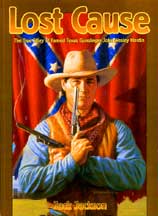 Moving to the west coast, and working as an accountant, Jackson ran into other Texans, of which there was a very large number. One group had started a company, the Rip Off Press but could not make a business of it. Jackson stepped up to the plate and his acumen was instrumental in making the effort into a financially viable business and eventually the premiere underground comic publisher. The promises of the alternative life-style of that era faded along with the profitability of the business. Jackson moved back to Austin and began to create western history stories about Quanah Parker, a Comanche chief with a white mother who became a landowner of note in the Texas panhandle. Originally published in Last Gasp Comics they were later collected into a trade paperback entitled Comanche Moon whose commercial success and critical acclaim on two continents led him into the graphic novel form which he had a strong hand in forming.
Moving to the west coast, and working as an accountant, Jackson ran into other Texans, of which there was a very large number. One group had started a company, the Rip Off Press but could not make a business of it. Jackson stepped up to the plate and his acumen was instrumental in making the effort into a financially viable business and eventually the premiere underground comic publisher. The promises of the alternative life-style of that era faded along with the profitability of the business. Jackson moved back to Austin and began to create western history stories about Quanah Parker, a Comanche chief with a white mother who became a landowner of note in the Texas panhandle. Originally published in Last Gasp Comics they were later collected into a trade paperback entitled Comanche Moon whose commercial success and critical acclaim on two continents led him into the graphic novel form which he had a strong hand in forming.
He eventually created stories from the Mexican point of view, Los Tejanos and Los Mestenos, Spanish Ranching In Texas, 1721 – 1821, from the Cherokee point of view, Indian Lover: Sam Houston And The Cherokees, from the Texakan point of view in The Alamo, and from the white Southerners point of view, Lost Cause: The True Story Of Famed Texas Gunslinger John Wesley Hardin. Each story is completely faithful to the events they portray. They look unflinchingly at every side, fair and accurate to each and all. These and others were so meticulously detailed, so completely researched, that he was named lifetime fellow of the Texas Historical Society, an award previously restricted to historians of a more traditional background and literary output.
Throughout this extended period his muscular condition continued to deteriorate. Most of his work was produced despite the fact that he was unable to hold a drawing instrument. Eventually muscles were transplanted from other parts of his body to his hands but this was a temporary fix. Early in June of this year, feeling he was incapable of carrying on the work he did so well, he had a long discussion with his son to assure him of his admiration and love, drove to his parents grave site and shot himself. One cannot but think of Monet who, late in life, crippled with arthritis, had a trench dug in his garden so that mammoth canvases could be raised and lowered to his painting height, had brushes tied to the claws that once were his hands, and painted what are today his signal works, the water lily series. What else could Jack Jackson have brought us? We will never know, but in any case that question is formed from a selfish desire to get more of a good thing. None knows the burdens carried by another. It is enough to know that a great talent has passed and that the bell is tolling.
Indian Lover RATING: 
Lost Cause RATING: 
Jack Jackson RATING: 
![]()

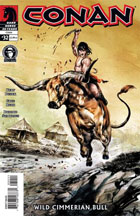 Conan # 32 (Dark Horse) – Bridging the gap between Mike Mignola’s short stint on the title and Tim Truman assuming the mantel next month, writer Kurt Busiek and artist Greg Ruth return for another “Born on the Battlefield” stand-alone story about Conan’s formative years. Here, Conan is a strong and forceful teenager – the cock of the walk – not above taking another man’s woman on a whim, even from a fellow Cimmerian. He is in all his actions unquestioned and unchallenged. Sooner or later though, that kind of mentality is bound to get a barbarian in trouble. Much of Busiek’s run on the title focused on a younger Conan, just starting his adventures in Hyperboria, often portrayed as a charismatic and brash bully. This issue provides some more context for the younger Conan’s arrogance, before he became wiser and more astute. It’s good character development, and Ruth’s fluid and loose style evokes a hazy and dreamlike atmosphere perfectly suited for this flashback tale. A solid little vignette about what made Conan “Conan.” – Sean
Conan # 32 (Dark Horse) – Bridging the gap between Mike Mignola’s short stint on the title and Tim Truman assuming the mantel next month, writer Kurt Busiek and artist Greg Ruth return for another “Born on the Battlefield” stand-alone story about Conan’s formative years. Here, Conan is a strong and forceful teenager – the cock of the walk – not above taking another man’s woman on a whim, even from a fellow Cimmerian. He is in all his actions unquestioned and unchallenged. Sooner or later though, that kind of mentality is bound to get a barbarian in trouble. Much of Busiek’s run on the title focused on a younger Conan, just starting his adventures in Hyperboria, often portrayed as a charismatic and brash bully. This issue provides some more context for the younger Conan’s arrogance, before he became wiser and more astute. It’s good character development, and Ruth’s fluid and loose style evokes a hazy and dreamlike atmosphere perfectly suited for this flashback tale. A solid little vignette about what made Conan “Conan.” – Sean
RATING: 
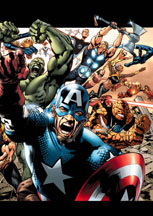 The Ultimates Volume 2 #12 (Marvel) It’s the big one: The Ultimates take back America, and we are all reminded just why we’re willing to put up with Bryan Hitch books being late. Because, make no mistake, this one’s all about Hitch. That’s not to say that writer Mark Millar’s contribution isn’t noted—among other things, he comes up with the niftiest fight between super-speed characters that I think I’ve ever seen—but you’ll barely notice his subtleties among the jaw-dropping fight scenes. Because everybody gets one—Cap vs Al-Rahman, Hulk vs Abomination… Jan and Qucksilver and the EU heroes get into the act, and Iron Man Six alone would make this issue worth reading. Every page a throwdown, thirty-seven of ‘em for your four bucks; brutal, densely-populated, insane with detail. And after all that, we have a final page that suggests that issue #13’s wrapup will be only slightly less wild. My only minor quibble would be the fact that the various other heroes (Spider-Man, FF, X-Men) pictured on the cover are only in the book for about the same length of time as they are on the cover: one jumungous two-page action spread (though, frankly, if it had been in the middle of the book, I’d have bought two copies to pull that spread out and mount it). Apart from that, it’s the ultimate (well, technically penultimate) Ultimate spectacular. I understand Marvel’s desire to keep the series going with a new creative team next year, but honestly, no one’s gonna follow these guys. – Jeb D.
The Ultimates Volume 2 #12 (Marvel) It’s the big one: The Ultimates take back America, and we are all reminded just why we’re willing to put up with Bryan Hitch books being late. Because, make no mistake, this one’s all about Hitch. That’s not to say that writer Mark Millar’s contribution isn’t noted—among other things, he comes up with the niftiest fight between super-speed characters that I think I’ve ever seen—but you’ll barely notice his subtleties among the jaw-dropping fight scenes. Because everybody gets one—Cap vs Al-Rahman, Hulk vs Abomination… Jan and Qucksilver and the EU heroes get into the act, and Iron Man Six alone would make this issue worth reading. Every page a throwdown, thirty-seven of ‘em for your four bucks; brutal, densely-populated, insane with detail. And after all that, we have a final page that suggests that issue #13’s wrapup will be only slightly less wild. My only minor quibble would be the fact that the various other heroes (Spider-Man, FF, X-Men) pictured on the cover are only in the book for about the same length of time as they are on the cover: one jumungous two-page action spread (though, frankly, if it had been in the middle of the book, I’d have bought two copies to pull that spread out and mount it). Apart from that, it’s the ultimate (well, technically penultimate) Ultimate spectacular. I understand Marvel’s desire to keep the series going with a new creative team next year, but honestly, no one’s gonna follow these guys. – Jeb D.
RATING: 
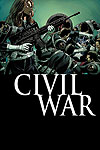 Captain America # 22 (Marvel) – This is quite possibly Marvel’s best superhero title right now – an exciting combination of superheroes and espionage. The first issue in a new story-arc, Captain America # 22 kicks off a five-part “Civil War” tie-in focusing on the reasons behind Captain America’s decision to oppose the Super Human Registration Act and the effect that decision is having on the lives of the people closest to him. Told from the perspective of Sharon Carter, SHIELD Agent and Steve Roger’s lover, this issue alone sheds more light on Cap’s motivations than the “Civil War” mini-series itself. Series writer Ed Brubaker is doing an outstanding job highlighting the richness and complexities of this character. Here, Carter and Rogers engage in a rich philosophical debate, with Rogers quoting Thomas Paine and Benjamin Franklin to point out the folly of trading freedom for “security” and the reluctance of our forefathers to do so. It’s topical, but not in a way that interferes with the narrative. (In fact, brace yourself for yet another Brubaker twist showing that although this is a “Civil War” tie-in, the scribe isn’t hitting the pause button on his own stories.) Engaging stuff. Kudos also to artist Mike Perkins for another outstanding “fill-in.” – Sean
Captain America # 22 (Marvel) – This is quite possibly Marvel’s best superhero title right now – an exciting combination of superheroes and espionage. The first issue in a new story-arc, Captain America # 22 kicks off a five-part “Civil War” tie-in focusing on the reasons behind Captain America’s decision to oppose the Super Human Registration Act and the effect that decision is having on the lives of the people closest to him. Told from the perspective of Sharon Carter, SHIELD Agent and Steve Roger’s lover, this issue alone sheds more light on Cap’s motivations than the “Civil War” mini-series itself. Series writer Ed Brubaker is doing an outstanding job highlighting the richness and complexities of this character. Here, Carter and Rogers engage in a rich philosophical debate, with Rogers quoting Thomas Paine and Benjamin Franklin to point out the folly of trading freedom for “security” and the reluctance of our forefathers to do so. It’s topical, but not in a way that interferes with the narrative. (In fact, brace yourself for yet another Brubaker twist showing that although this is a “Civil War” tie-in, the scribe isn’t hitting the pause button on his own stories.) Engaging stuff. Kudos also to artist Mike Perkins for another outstanding “fill-in.” – Sean
RATING: 
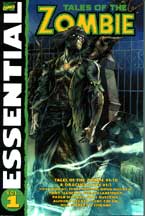 The Essential Tales Of The Zombie Volume #1 (Marvel) Once Creepy, Eerie, and Vampirella demonstrated that magazine sized black and white comics would sell at a competitive price alongside other magazines, Marvel jumped on board with a Spiderman mag, Deadly Hands of Kung-Fu, The Hulk, and others. Some lasted a very short time while others did reasonably well. Here are collected the first ten issues of the Tales of the Zombie and zombie stories from the first two issues of Dracula Lives. There are a variety of artists, styles, and stories all revolving around the traditional concept of the living dead. The title stories all follow the "adventures" and "life" of one man, Simon Garth, brought back to do the bidding of one evil man, then continue as Simon seeks the peace of the grave issue after issue. Interspersed are text reviews of zombie movies, facts about voodoo, and other such amusements. This is not George Romero. It’s certainly not The Walking Dead. There is some interesting art, especially that by Alfredo Alcala. But the stories are all much the same. Everyone should support the Essential reprint series, but there is no overriding reason to immediately rush out and add this volume to the book shelf. – Elgin
The Essential Tales Of The Zombie Volume #1 (Marvel) Once Creepy, Eerie, and Vampirella demonstrated that magazine sized black and white comics would sell at a competitive price alongside other magazines, Marvel jumped on board with a Spiderman mag, Deadly Hands of Kung-Fu, The Hulk, and others. Some lasted a very short time while others did reasonably well. Here are collected the first ten issues of the Tales of the Zombie and zombie stories from the first two issues of Dracula Lives. There are a variety of artists, styles, and stories all revolving around the traditional concept of the living dead. The title stories all follow the "adventures" and "life" of one man, Simon Garth, brought back to do the bidding of one evil man, then continue as Simon seeks the peace of the grave issue after issue. Interspersed are text reviews of zombie movies, facts about voodoo, and other such amusements. This is not George Romero. It’s certainly not The Walking Dead. There is some interesting art, especially that by Alfredo Alcala. But the stories are all much the same. Everyone should support the Essential reprint series, but there is no overriding reason to immediately rush out and add this volume to the book shelf. – Elgin
RATING: 
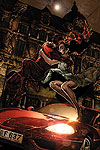 Daredevil # 89 (Marvel) – The name’s Murdock, Matt Murdock. Series writer Ed Brubaker puts an espionage spin on Daredevil for this story-arc, which finds Matt Murdock in Monte Carlo on the trail of Foggy Nelson’s “killer.” I remember chatter on various message boards asking how anyone could possibly follow Brian Michael Bendis’ incredible run on this title, but Brubaker has and he’s done so by making the title his own. He’s mixed it up and put Matt Murdock in situations we haven’t seen him in (i.e. in prison for his first story arc, and now globe trotting across Europe ala James Bond on the hunt for an assassin), and he’s thrown in more twists than a box full of pretzels. It’s fresh and you never know what to expect. Add to that the noir stylings of Michael Lark as the series artist and Daredevil is one of Marvel’s premier books month in and month out. – Sean
Daredevil # 89 (Marvel) – The name’s Murdock, Matt Murdock. Series writer Ed Brubaker puts an espionage spin on Daredevil for this story-arc, which finds Matt Murdock in Monte Carlo on the trail of Foggy Nelson’s “killer.” I remember chatter on various message boards asking how anyone could possibly follow Brian Michael Bendis’ incredible run on this title, but Brubaker has and he’s done so by making the title his own. He’s mixed it up and put Matt Murdock in situations we haven’t seen him in (i.e. in prison for his first story arc, and now globe trotting across Europe ala James Bond on the hunt for an assassin), and he’s thrown in more twists than a box full of pretzels. It’s fresh and you never know what to expect. Add to that the noir stylings of Michael Lark as the series artist and Daredevil is one of Marvel’s premier books month in and month out. – Sean
RATING: 
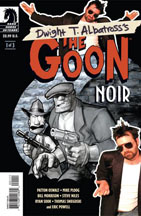 The Goon Noir # 1 of 3 (Dark Horse) – Dwight Albatross, the hilarious and crass “personality” from The Goon’s letter page, “takes over” the direction of the series for three issues, shifting the format from full color stand-alone stories to a black and white anthology. Contributors to this issue include Steve Niles, Ryan Sook, Thomas Sniegoski and series creator Eric Powell – and while each piece has its merits the clear stand-out is Bill Morrison’s “Hey Goon, Comics!,” a hysterical send-up of the old Yogi Bear cartoons featuring bear caricatures of the Goon and his sidekick Franky busting up zombie picnics. This story alone is worth the price of admission. Oddly enough, (and to my disappointment) The Goon Noir is almost “noir” in name only. Aside from the black and white art and a few scenes with a femme fatale, this book is no more noir than the regular series – much, much less so in my opinion. Still these are some entertaining black comedy / horror vignettes. – Sean
The Goon Noir # 1 of 3 (Dark Horse) – Dwight Albatross, the hilarious and crass “personality” from The Goon’s letter page, “takes over” the direction of the series for three issues, shifting the format from full color stand-alone stories to a black and white anthology. Contributors to this issue include Steve Niles, Ryan Sook, Thomas Sniegoski and series creator Eric Powell – and while each piece has its merits the clear stand-out is Bill Morrison’s “Hey Goon, Comics!,” a hysterical send-up of the old Yogi Bear cartoons featuring bear caricatures of the Goon and his sidekick Franky busting up zombie picnics. This story alone is worth the price of admission. Oddly enough, (and to my disappointment) The Goon Noir is almost “noir” in name only. Aside from the black and white art and a few scenes with a femme fatale, this book is no more noir than the regular series – much, much less so in my opinion. Still these are some entertaining black comedy / horror vignettes. – Sean
RATING: 
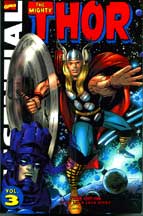 The Essential Thor Volume # 3 (Marvel) Having created a character from the legends of Norse gods, whose power was practically unlimited, it should have been immediately clear to both Kirby and Lee that they had, to a certain degree, painted themselves into a corner. Villains had to become more and more powerful, and stories more and more immense. This volume eventually carries Thor far from Earth against ever more powerful opponents until he faces Galactus, Eater Of Worlds. Here the artwork is the pinnacle of Kirby-ness, but the story limitations of such a powerful hero have become all too apparent. A lead character who has no real weaknesses and practically nothing to fear, cannot truly be called a hero, especially when spouting dialogue written by someone to whom poor interpretations of Elizabethan language seems the height of literacy and regal bearing (easily the most irritating invention by Stan Lee in the entire history of Marvel). If you loved, or missed, the early Thor, this is a must have volume. If you caught them the first time around this is a reasonably enjoyable review. – Elgin
The Essential Thor Volume # 3 (Marvel) Having created a character from the legends of Norse gods, whose power was practically unlimited, it should have been immediately clear to both Kirby and Lee that they had, to a certain degree, painted themselves into a corner. Villains had to become more and more powerful, and stories more and more immense. This volume eventually carries Thor far from Earth against ever more powerful opponents until he faces Galactus, Eater Of Worlds. Here the artwork is the pinnacle of Kirby-ness, but the story limitations of such a powerful hero have become all too apparent. A lead character who has no real weaknesses and practically nothing to fear, cannot truly be called a hero, especially when spouting dialogue written by someone to whom poor interpretations of Elizabethan language seems the height of literacy and regal bearing (easily the most irritating invention by Stan Lee in the entire history of Marvel). If you loved, or missed, the early Thor, this is a must have volume. If you caught them the first time around this is a reasonably enjoyable review. – Elgin
RATING: 
So ends this accounting of valiant warriors and high adventure! Return next week to honor still more comics. Praise Odin.
To discuss this column and all things Nordic, or if you have a comic you want to submit for review, contact Sean at scfahey@yahoo.com.